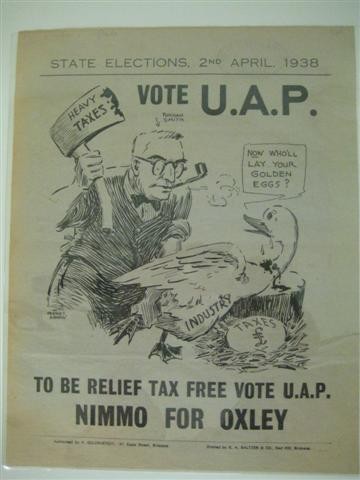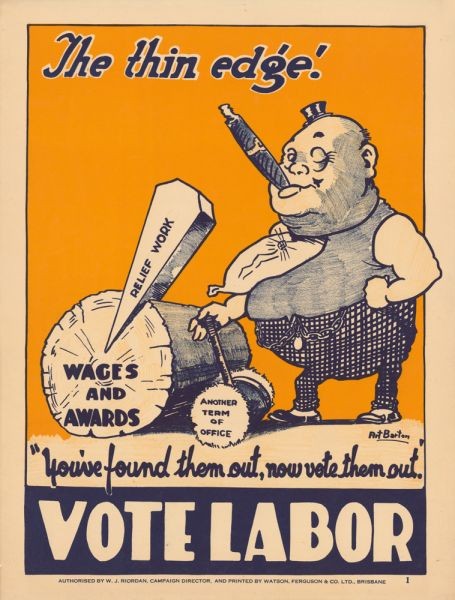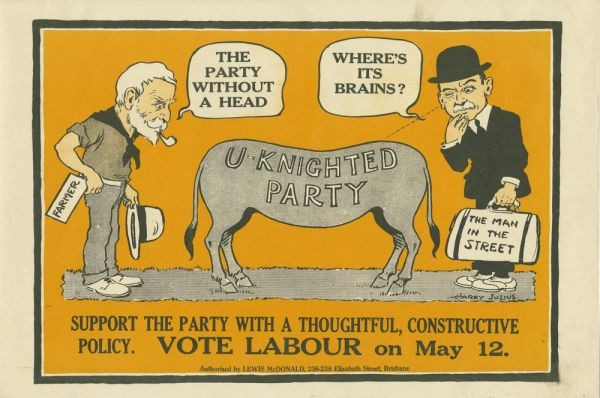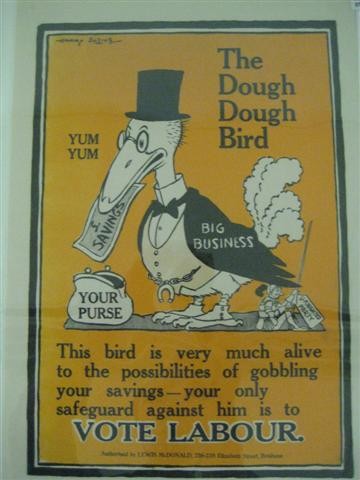In the lead-up to the recent announcement of the Queensland state elections on March 24th, a question was posed about the purpose and significance of political ephemera.
Why, it was put to us, would a state library wish to collect representative specimens of the transient mass of political propaganda which swamps voters every three years in the course of a few fevered campaigning days? The persuasive pledges and promises and undertakings encapsulated on posters and cards, most of them destined, the morning after, to be recycled as scrap paper or relegated to the nearest landfill, along with the badges, fridge magnets, calendars and other paraphernalia accruing at scores of voting booths around the city, state or nation?
Of what value, given the millions of words penned by historians, political analysts, commentators and journalists on the history and course of local, state and federal elections, is this sort of material to succeeding generations of researchers, students and interested laypeople? How do mere artefacts add to our understanding of what were the substantial issues of the day, the debates and the stances taken by those who have represented us in political forums over the years, the concerns of constituents exercising their democratic right to vote?
The answer, as we raked through draws of classified posters and amassed an impressive cluster of archival pamphlet boxes filled with the detritus of past elections, declared itself early in the piece. An item of ephemera, we saw at once, brings the history alive, it speaks the thousand words proverbially claimed for the picture, it is the primary evidence, the gritty, visceral stuff which somehow captures a moment in political history in a way that enriches, rather than replicates, the reportage.
And in the very strictest understanding of the term "ephemera" its distinctive characteristic is, obviously, that it is literally here today and lost to posterity tomorrow - that is, if no-one makes the very deliberate effort to collect it. It is for this reason that the State Library needs to enlist the help of residents throughout the state of Queensland in preserving the electoral history of Queensland.
The assistance we particularly need relates to the non-metropolitan areas of the state. Whilst an enthusiastic group of State Library staff have competently collected ephemera from Brisbane electorates in past elections, it is beyond our capacity to cover the rest of Queensland. Anything which qualifies as political ephemera - how-to-vote cards, badges, leaflets, signs, even t-shirts - will receive a welcome home in the John Oxley Library, as long as we don't already hold a duplicate copy.

Those of you who have visited the compelling Queensland Votes exhibition on level 4 of the State Library will need no convincing about the value of political memorabilia or about its ability to evoke our political past. But in the event that anyone is in doubt, I only need to point to a few potent examples, brought to light in our recent efforts to answer the question alluded to earlier.
Among the drawfuls of posters making their strident cases to secure your vote for one political party or another, the work of two prominent poster artists is particularly arresting. Art Barton (1887-1974) nicknamed the "Rembrandt of Luna Park" was for 35 years" a widely admired, resident Luna Park artist who produced a number of sketches, comic strips, comic books and some political posters.
The Thin Edge is one of the eight Art Barton posters held in the John Oxley Library's collection. Created for the 1932 state election, it is a sober reminder of Depression era issues and concerns. Labor, who had held uninterrupted power from 1915 to 1929, had lost office in1929 to the Country and Progressive National Party government led by Arthur Moore. In the 1932 state election the ALP, led by William Forgan-Smith was targeting Moore's record in addressing unemployment and working conditions. A corpulent, cigar smoking caricature with expensive (presumably gold) watch chain, diamond flashing in his neck-tie, is seen to be taking advantage of relief work measures, using a mallet labelled “another term in office” to drive a wedge into wages and conditions. In another Art Barton poster Moore's Workless Army depicts a crowd of unemployed men and women turning towards the polling booth and away from adjacent business establishments with notices such as 'No hands wanted' and 'Works closed' pasted on the walls. In a further variation on the same theme He Still Can’t Get a Job makes the point that “under the Nationalist government” factories have closed down while the ranks of the unemployed have swollen.

Another poster artist whose distinctive work puts a definite spin on the election issues of the day is Harry Julius (1885-1938), an early 20th century cartoonist, caricaturist, printmaker, illustrator, commercial artist and publisher. And it is in particular the suite of posters he created for the 1923 state elections - and the collection of political pamphlets which inform the promotional material - which attracted our attention. The circumstances - a sitting Labor government campaigning on the basis of several consecutive terms in office, defending its record in government, opposed by a conservative coalition (caricatured in this instance as the “U-Knighted Party”) - are to some extent reminiscent of the current state election scenario.

A number of campaign themes appear to have survived the course of almost ninety years: the courting of the farmer’s vote (expressed quaintly in one pamphlet as “The Labour Policy keeps watchful guard over all Profiteers in Produce, who Batten and Fatten at the expense of the man on the land”), accusations of a biased media, guilty of “downright distortion and malignant misrepresentation”, a defence of sound economic management (“in Queensland the cost of living is lower, wages are higher and working hours are shorter”); and claims made about the labour market (“Queensland’s Labour Government has…laid the spectre of unemployment low and dispelled its threatening shadow”.)
The posters and pamphlets bear witness both to the survival of some essential political issues and to the transformation of our living standards, our aspirations and our sensibilities. Achievements claimed for the Labour Movement include, for example, free education, workers' compensation, old age pensions, baby clinics, factories and shops legislation, co-operative agricultural "pools", state butchers' shops ("to give cheap and wholesome food"), maternity hospitals, government labour exchanges, water conservation policy, compensation to "sufferers from Miners' Phthisis", workers' homes for the "toilers of the State" (who could build a home for £500). Topping a list of "notable reforms" is not the dismantling, but the strengthening, of the White Australia policy.
The posters consistently make a stand for the worker and oppose the vested interests of "big business" - "landlordism" and exorbitant rents being a case in point; they warn about the threat to living standards and working conditions achieved through labour reforms and about the distortions of the "capitalist press". Two representative examples which are typically short on subtlety: The Dough Dough Bird's message is that your savings are likely to be gobbled up unless you vote Labor. A greedy dough dough bird dressed in top hat, pince-nez perched superciliously on its long beak, a big business label on its waistcoat, plucks a pound note from the public purse, aided and abetted by a knight in armour who represents the "U-Knighted Party"; in Take No Notice of Calamity Howlers the Tory press holds up a distorted image of a snarling, armed character brandishing a Communist tract, a bomb marked "Revolution" in his hand. Leaving no room for misinterpretation, the pen of the Tory press is dipped in an ink bottle of "venom".

These are just a very few examples of some of the fascinating - and historically important - items in the State Library's ephemera collections. Today the small bundle of how-to-vote cards you salvage from your visit to the local polling booth may not seem to compete with the significance of, say, the 1906 campaign tract which boasts that Labor (Labour) has ended the Kanaka trade. In time to come, however, who is to know what importance might accrue to your contribution in the eyes of future researchers.
If you would like to contribute to the statewide effort to preserve the electoral history of Queensland, your course of action is as follows: rather than discard what might seem to be the election day equivalent of junk mail, place those potentially valuable artefact(s) in an envelope and send them to:
Election Ephemera
Queensland Memory
State Library of Queensland
PO Box 3488
South Brisbane QLD 4101
Libby Fielding - Legal Deposit Coordinator, State Library of Queensland
Comments
Your email address will not be published.
We welcome relevant, respectful comments.